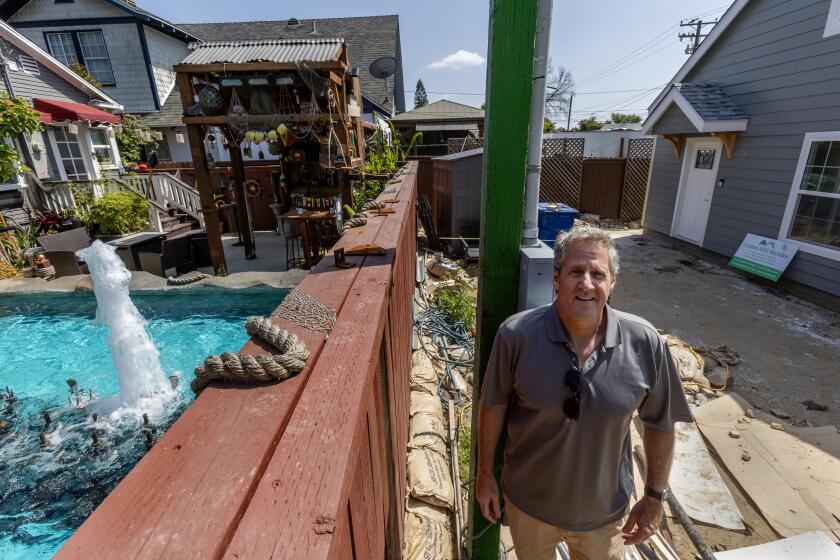Hospital plagued by fumes
Los Angeles County-USC Medical Center shut down its rooftop helicopter pad Friday, months after exhaust fumes began leaking into the new hospital’s ventilation system.
The move, announced after The Times made inquiries about chronic problems with the ventilation system at the state-of-the-art, $1.02-billion facility, came one month after state officials began investigating complaints.
Significant problems with helicopter exhaust seeping into hospitals have been well-documented in recent years -- with pilots groups warning those building new facilities not to locate vents too close to helipads -- raising questions about why the issue has occurred at the county’s newest facility.
County-USC’s ventilation system problems were apparent soon after the hospital opened in November, said Pete Delgado, the hospital’s chief executive.
Fumes from helicopters landing on the roof with critically ill patients triggered fire alarms and caused fire protective doors to automatically close in the hospital, he said.
As of Friday morning, helicopters were being rerouted to the facility’s old, ground-based helipad.
Patients arriving by air must now be taken by ambulance to the emergency room about half a mile away.
Hospital officials said they decided to halt rooftop landings “in the interest of ensuring the safety of employees and staff from the fumes until the issue can be resolved,” said Michael Wilson, spokesman for the Los Angeles County Department of Health Services.
The shift means it will take critically ill patients longer to arrive in the emergency room. The rooftop helipad, an elevator ride away from the emergency department, was designed to cut transport times.
The decision came despite Cal/OSHA testing that showed carbon monoxide levels in the hospital two weeks ago were well within what the state considers to be safe.
Still, hospital officials conceded that odors from the exhaust fumes have been getting progressively worse since November as carbon filters installed to mitigate the problem continue to get depleted. Luis Fonseca, County-USC’s facilities director, said $90,000 in replacement filters, enough to change out 900 primary filters, will not arrive until Feb. 27 because they are on back order.
The affected air vents circulate air through the hospital’s diagnostic and treatment building, which houses the 120,000-square-foot emergency department and 25 operating rooms.
“It’s been going on since Day 1,” said X-ray technician John Sturkie, who on Monday left work early complaining of nausea and a headache.
“When they first land, you get a waft . . . then it builds,” he said, comparing the smell to bus exhaust. “Obviously, the longer they’re idling there, the more exhaust is sucked into the system. . . . It gets really powerful.”
In 2004, the Federal Aviation Administration warned that air quality in buildings could be compromised if heliports were located too close to fresh-air vents.
“These issues should be resolved during facility design,” the recommendation said.
Fonseca, the County-USC facilities director, said he did not believe there was a design flaw at the hospital. He said he believes that once the filters are replaced, the odors will stop.
But some hospital officials who have dealt with exhaust problems elsewhere warn that filters proved insufficient.
Childrens Hospital Los Angeles has lived with helicopter fumes bothering staff and patients since 1990.
The 41-year-old hospital has sealed outside areas of the building where odor leakage could occur and installed carbon filters on rooftop air vents, said hospital spokesman Steve Rutledge.
The efforts have reduced the odor, but some inside the hospital remain sensitive to the fumes, Rutledge said. Architects working on a new facility, scheduled to open next year, have made it a priority to avoid such problems, he said.
The University of Michigan’s hospital in Ann Arbor spent $3 million between 1994 to 1998 trying to correct the problem, including reducing helicopter idling time, trying to flush out odors by increasing ventilation rates, and placing air handling units into a “recirculation mode” when helicopters landed or took off.
The hospital also spent more than $250,000 a year on charcoal filters to improve air filtering and paid to seal air handlers to prevent odors from seeping through. None of it worked.
When officials needed to replace the leaky roof, the university scuttled the rooftop helipad. In 2001, they opened a ground-based heliport and a tunnel connecting it to the hospital at a cost of about $5 million.
Hospital officials there are heeding that lesson as they design the rooftop heliport for a new children’s hospital. The helipad will be placed atop the 12-floor building, but the air intakes will be placed on the second floor.
The design that gave them so many problems had vents located one floor beneath the helipad, similar to the configuration used by County-USC.
Experts who have looked at hospital helipad designs say it’s not uncommon for architects to design air venting systems to be located near the helipad because air circulation systems are typically located on the roof.
“That’s why we recommend when an architect sits down to do a helipad, it’s not a bad idea to get a consultant from an organization that does them on a regular basis,” said Rex Alexander, a member of the board of directors of the Utah-based National EMS Pilots Assn.
It was unclear Friday whether the county went through such a process when designing County-USC. One of the architects, HOK of Los Angeles, said Friday that the firm’s contract with the county prohibited it from commenting. LBL Associated Architects of Santa Monica, the other architect, did not return a call seeking comment.
--
Times researcher Vicki Gallay contributed to this report.
More to Read
Start your day right
Sign up for Essential California for news, features and recommendations from the L.A. Times and beyond in your inbox six days a week.
You may occasionally receive promotional content from the Los Angeles Times.







